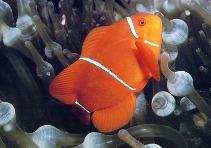| Family: |
Pomacentridae (Damselfishes), subfamily: Pomacentrinae |
| Max. size: |
17 cm TL (male/unsexed) |
| Environment: |
reef-associated; marine; depth range 1 - 16 m, non-migratory |
| Distribution: |
Indo-West Pacific: Indo-Australian Archipelago including India, Burma, Thailand, Malaysia, Indonesia, Philippines, New Guinea, New Britain, Solomon Islands, Vanuatu, and Australia (northern Queensland). |
| Diagnosis: |
Dorsal spines (total): 10-10; Dorsal soft rays (total): 17-18; Anal spines: 2-2; Anal soft rays: 13-15. Description: Has a distinctive prominent preopercular spine that extends across the head-bar. Juveniles and males bright red, females become maroon to nearly black (Ref. 37816). Males are much smaller than females (Ref. 48636). Body depth 1.9-2.0 in SL (Ref. 90102). |
| Biology: |
Adults inhabit lagoon and seaward reefs (Ref. 9710), found mainly in protected coastal waters and lagoons. Typically found in pairs in which males are much smaller than females (Ref. 48636). Feed primarily on zooplankton and benthic algae (Ref. 4966). Oviparous, distinct pairing during breeding (Ref. 205). Eggs are demersal and adhere to the substrate (Ref. 205). Males guard and aerate the eggs (Ref. 205). Associated with the anemone Entacmaea quadricolor (Ref. 5911). Have been reared in captivity (Ref. 35404, 35413, 35420). Diurnal species (Ref. 113699). |
| IUCN Red List Status: |
Least Concern (LC); Date assessed: 23 September 2021 Ref. (130435)
|
| Threat to humans: |
harmless |
Source and more info: www.fishbase.org. For personal, classroom, and other internal use only. Not for publication.

